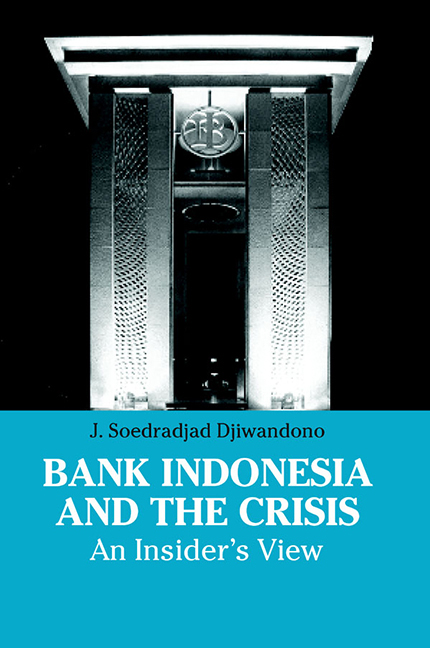Book contents
- Frontmatter
- Dedication
- Contents
- List of Tables
- Acknowledgements
- Glossary
- Prologue: The Crisis and Me
- 1 Introduction
- 2 Origin of the Crisis and Early Responses
- 3 Stabilization and Reform Programmes
- 4 Poor Programme Implementation
- 5 Stronger Programme with Weak Commitment
- 6 Bank Indonesia and the Crisis
- 7 Lessons from the Crisis
- 8 Epilogue
- Postscript
- Notes
- References
- Index
- About the Author
2 - Origin of the Crisis and Early Responses
Published online by Cambridge University Press: 21 October 2015
- Frontmatter
- Dedication
- Contents
- List of Tables
- Acknowledgements
- Glossary
- Prologue: The Crisis and Me
- 1 Introduction
- 2 Origin of the Crisis and Early Responses
- 3 Stabilization and Reform Programmes
- 4 Poor Programme Implementation
- 5 Stronger Programme with Weak Commitment
- 6 Bank Indonesia and the Crisis
- 7 Lessons from the Crisis
- 8 Epilogue
- Postscript
- Notes
- References
- Index
- About the Author
Summary
Home Grown but Not Home Alone
During the first year of the Asian crisis, discussions among experts and writings in the media and professional journals had not been clear in showing the origins or development of the crisis.
Only after more than a year of confusion did some kind of general consensus emerge on the causes of the crisis, policy responses by governments, as well as market reactions toward the crisis. The different views on these matters could be traced to the different perspectives on economics, which are more difficult to mediate.
The differences seem to arise from different schools of thought, which may be based on the conventional distinction between classical and Keynesian economics. Simply put, classical economists rest their arguments on the belief in market mechanisms and argue that any form of intervention in the market is to be avoided because it creates distortion. In contrast, Keynesian economists argue that the market is basically unstable and that government should intervene to create stability.
Analyses about the Asian crisis itself can be distinguished in two broad groups. The first group argues that the crisis was home grown and arose from practices of crony capitalism and weak financial structures plus inept macroeconomic policies (Krugman 1998). The second group saw the crisis as triggered by a shift of sentiment in the financial market that caused financial panic. The second view argues that the crisis was basically a financial panic in the Keynesian tradition, as succinctly explained by Charles P. Kindleberger in his seminal work two decades ago (Kindleberger 1978). Jeffrey Sachs has been the major proponent of this view (Radelet and Sachs 1998).
Stephan Haggard refers to the first group as the internationalists and the second, the fundamentalists. In addition, he also mentions the existence of the third group; these he refers to as the new fundamentalists, who specifically mention weak regulations and institutions in the financial sector as the cause of the crisis (Haggard 2000, p. 4).
With respect to the Indonesian crisis, similar questions could be asked.
- Type
- Chapter
- Information
- Bank Indonesia and the CrisisAn Insider's View, pp. 22 - 75Publisher: ISEAS–Yusof Ishak InstitutePrint publication year: 2005



